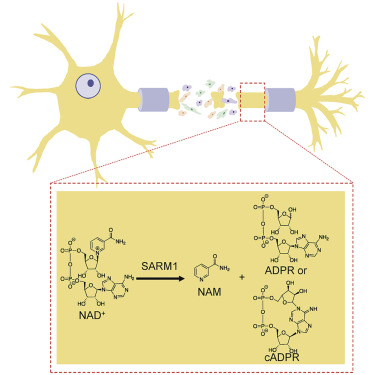当前位置:
X-MOL 学术
›
Cell Chem. Bio.
›
论文详情
Our official English website, www.x-mol.net, welcomes your feedback! (Note: you will need to create a separate account there.)
Emergence of SARM1 as a Potential Therapeutic Target for Wallerian-type Diseases.
Cell Chemical Biology ( IF 8.6 ) Pub Date : 2019-11-21 , DOI: 10.1016/j.chembiol.2019.11.002 Heather S Loring 1 , Paul R Thompson 1
Cell Chemical Biology ( IF 8.6 ) Pub Date : 2019-11-21 , DOI: 10.1016/j.chembiol.2019.11.002 Heather S Loring 1 , Paul R Thompson 1
Affiliation

|
Wallerian degeneration is a neuronal death pathway that is triggered in response to injury or disease. Death was thought to occur passively until the discovery of a mouse strain, i.e., Wallerian degeneration slow (WLDS), which was resistant to degeneration. Given that the WLDS mouse encodes a gain-of-function fusion protein, its relevance to human disease was limited. The later discovery that SARM1 (sterile alpha and toll/interleukin receptor [TIR] motif-containing protein 1) promotes Wallerian degeneration suggested the existence of a pathway that might be targeted therapeutically. More recently, SARM1 was found to execute degeneration by hydrolyzing NAD+. Notably, SARM1 knockdown or knockout prevents neuron degeneration in response to a range of insults that lead to peripheral neuropathy, traumatic brain injury, and neurodegenerative disease. Here, we discuss the role of SARM1 in Wallerian degeneration and the opportunities to target this enzyme therapeutically.
中文翻译:

SARM1作为Wallerian型疾病的潜在治疗靶点的出现。
沃勒氏变性是一种神经元死亡途径,其在对伤害或疾病的反应中被触发。人们一直认为死亡是被动发生的,直到发现了对退化具有抵抗力的小鼠品系,即Wallerian degeneration slow(WLDS)。鉴于WLDS小鼠编码功能增强融合蛋白,因此它与人类疾病的相关性受到限制。后来的发现表明SARM1(无菌的alpha和收费/白细胞介素受体[TIR]基序蛋白1)促进了Wallerian变性,这表明存在可能是治疗性靶向的途径。最近,发现SARM1通过水解NAD +进行变性。值得注意的是,SARM1敲除或敲除可防止神经元变性,以应对一系列导致周围神经病,颅脑外伤和神经退行性疾病的侮辱。
更新日期:2019-11-22
中文翻译:

SARM1作为Wallerian型疾病的潜在治疗靶点的出现。
沃勒氏变性是一种神经元死亡途径,其在对伤害或疾病的反应中被触发。人们一直认为死亡是被动发生的,直到发现了对退化具有抵抗力的小鼠品系,即Wallerian degeneration slow(WLDS)。鉴于WLDS小鼠编码功能增强融合蛋白,因此它与人类疾病的相关性受到限制。后来的发现表明SARM1(无菌的alpha和收费/白细胞介素受体[TIR]基序蛋白1)促进了Wallerian变性,这表明存在可能是治疗性靶向的途径。最近,发现SARM1通过水解NAD +进行变性。值得注意的是,SARM1敲除或敲除可防止神经元变性,以应对一系列导致周围神经病,颅脑外伤和神经退行性疾病的侮辱。



























 京公网安备 11010802027423号
京公网安备 11010802027423号